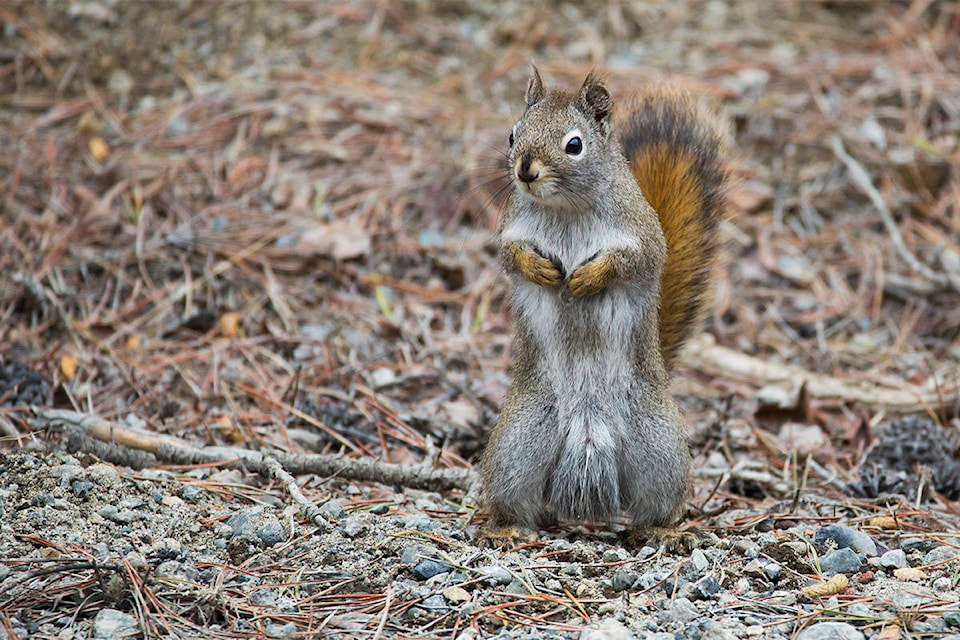For some, they’re the adorable tuffs of rust-coloured fur commonly spotted darting through wooded areas.
For others, they’re essentially tree-rats, borderline pests that dig up perfectly-planted flower beds and raid bird feeders.
Whatever your view on red squirrels is, chances are, even if you’ve seen a ton of them around, you probably don’t know too much about the little critters we share our backyards and forests with.
Yukon government biologist and wildlife harvest specialist Meghan Larivee is hoping to change that though with a free educational walk organized by Yukon Wildlife Viewing next week entitled “Ahhhhh nuts!”
In an interview July 24, Larivee, who told the News she’s “definitely fond” of red squirrels, described the rodents as “extremely fascinating creatures,” although she admitted she may be a “bit biased in that department.”
Although fairly ubiquitous across Canada, and even North America, red squirrels in the Yukon have set themselves apart in how they’ve learned to adapt to the North’s longer, colder winters and otherwise extreme environments.
For example, Larivee said, while red squirrels don’t hibernate, they’ll build tree nests to live in for the winter months, using their own body heat or, in some cases, cuddling with other squirrels to stay warm. The latter isn’t exactly a common occurrence, Larivee said, but when it does happen, it’s usually a female squirrel nesting with her offspring from the previous reproductive season.
Red squirrels in the North will also slightly lower their metabolic rate in colder times so that they’re expending as little energy as possible.
“We often think of small creatures as having to increase their metabolism to deal with cold temperatures, you know?” Larivee explained. “When you go outside you start shivering, you want to move around, stay warm — well red squirrels will actually lower their energy expenditure as much as possible and just kind of stay tucked in these little nests until there’s a warmer day where they can come out and enjoy the sun a little bit and warm up that way.”
Like their southern counterparts, red squirrels in the Yukon are also adept at creating food caches around their territories, specializing in munching on the seeds tucked inside the cones of coniferous trees. One squirrel requires somewhere in the ballpark of 30,000 cones in order to make it through the winter, Larivee said, and spend a “ton of energy” scampering around in the summer and fall months manically collecting and storing food before winter rolls around again.
Luckily for little guys, this happens to be an exceptional year for cones, thanks to a reproductive phenomenon observed in the humble white spruce tree.
“What this tree does is that every six or seven years, it’s not so predictable to be on the dot, but … it will produce a huge amount of cones. What that behaviour is called is masting, so that means that the trees, every few years, produce a huge amount of cones,” Larivee explained.
“And this is a strategy to sort of overwhelm seed predators — it’s funny to think of red squirrels as predators but they are predators of seeds — so that the squirrels can’t actually collect as many cones as the tree produces, and it allows the trees to have seeds that escape into the environment and then successfully produce new trees.”
Red squirrels in the Yukon, however, have somehow figured out how to predict when white spruces will mast, and will increase their population leading up to the expected explosion in cones — some females will have two litters of pups because they know there will be so much food to go around.
“It’s definitely a lot of work for the females, and up here, with the short growing season in the Yukon, it means that females are dealing with babies and pups that are starting to wean into the fall, when they also have to be thinking about about their own storage for food for the winter and hoarding cones, so they’re doing double-duty,” Larivee said.
“It’s pretty funny, they often look pretty haggard at that time of the year, females, you know, losing hair and sort of running every which way whereas the males, who don’t have to be raising pups or young actually look a lot better and have beautiful, glossy coats, so there’s really a difference between the amount of work that a female’s doing at this time of the year and what males are doing.”
Females squirrels may also be starting more turf wars because of the baby-squirrel boom — although pups are usually ready to leave the nest and strike out on their own by the time fall rolls around, mom will occasionally give them a helping hand.
Red squirrels are highly territorial creatures, and to survive the winter, each one must stake out its own area. To give their offspring a head start, female squirrels sometimes take over a neighbouring territory and manage two territories while she’s raising her young, with the idea that she can give the second territory to her favourite pup later on.
The mother squirrel may also give her own territory to a pup, because she knows she has a better chance of taking over another territory than an inexperienced juvenile.
“So it’s pretty much the same strategy as human sometimes,” Larivee said, “with having parents that maybe own two houses or offer their kids a downpayment on a first house, they’re sort of helping out the kids to get ahead a little bit and make sure that they have a good start in life.”
The “Ahhhhh nuts!” event is taking place at the Robert Service Campground on July 30 from 7 p.m. to 8:30 p.m. More information is available online at yukon.ca/events or by calling Yukon Wildlife Viewing at 667-8291.
Contact Jackie Hong at jackie.hong@yukon-news.com
